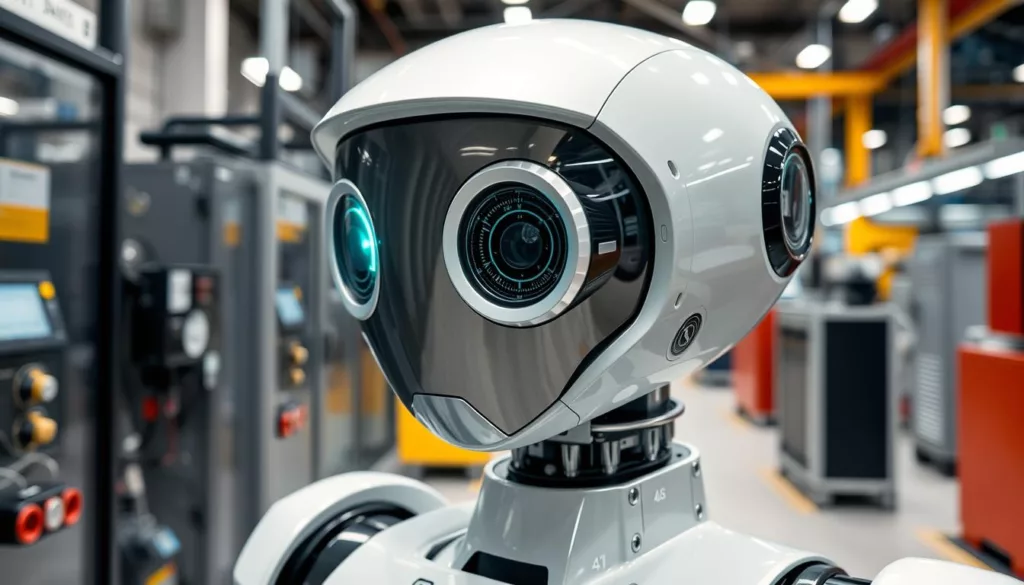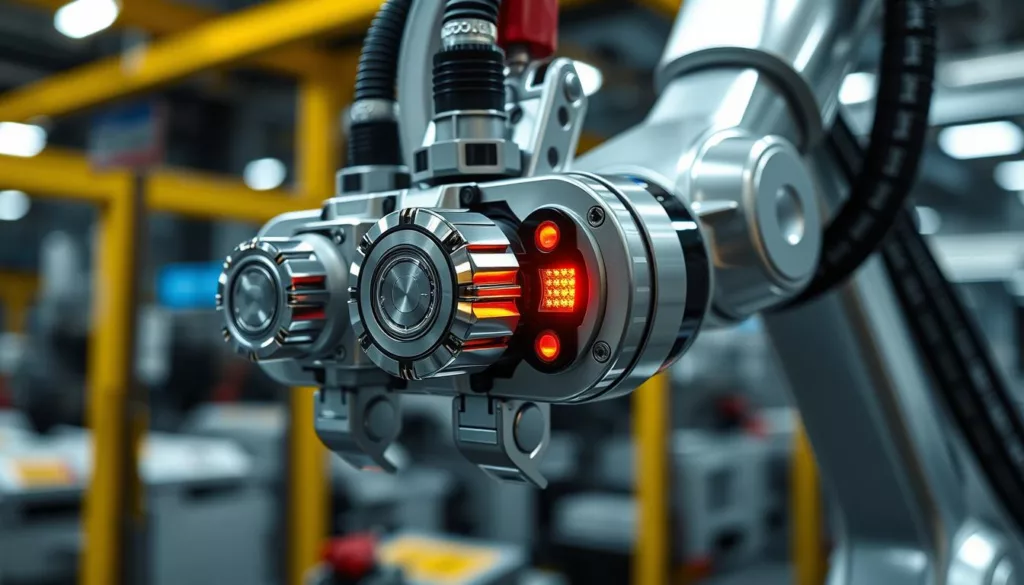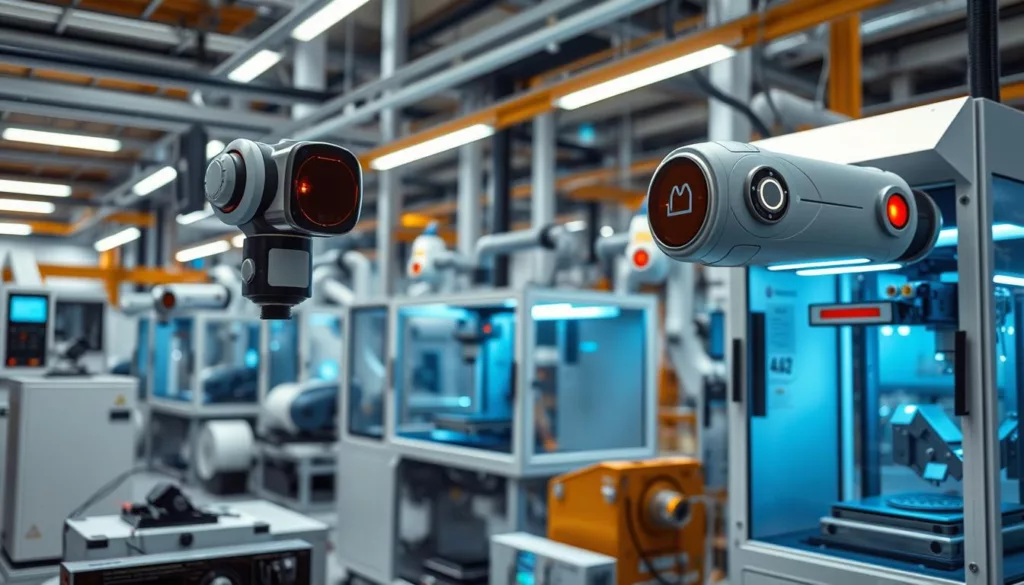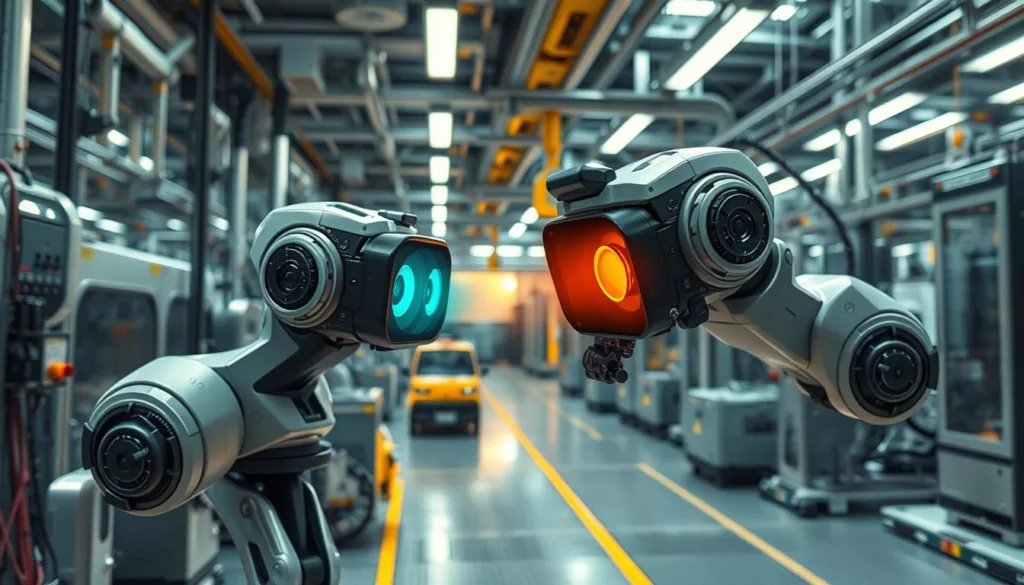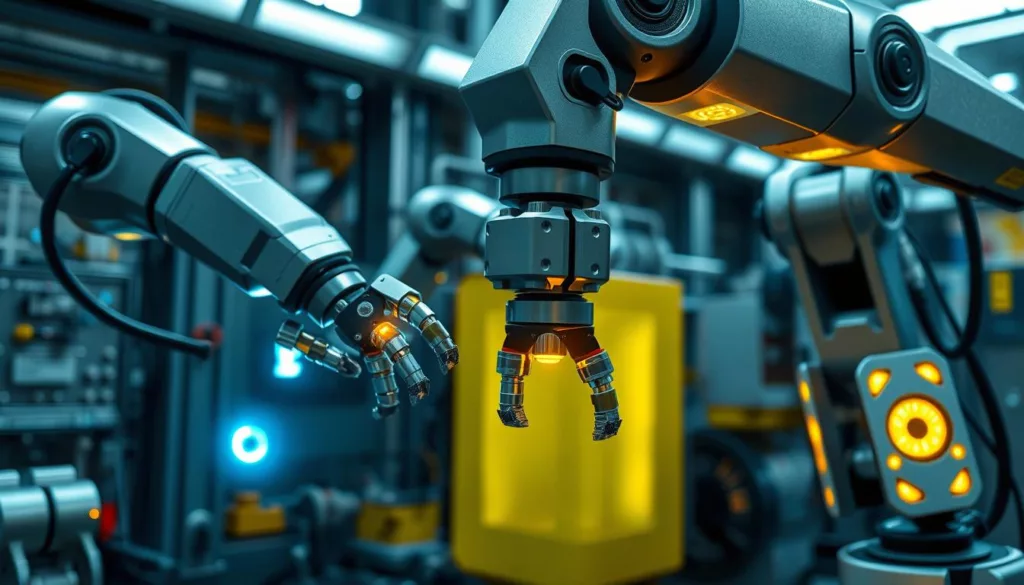The world of industry is changing fast, and so is the need for better robots. Service robots are key in making things better, faster, and safer. They use special sensors to work their best. Let’s look at the top sensors making service robots shine in factories.
Key Takeaways
- Proximity sensors, vision sensors, force and torque sensors, and inertial measurement units (IMUs) are the key sensor types used in service robots for industrial applications.
- These sensors enhance robot accuracy, precision, durability, and integration with existing systems, enabling them to excel in manufacturing environments.
- Proximity sensors provide critical collision avoidance and object detection capabilities, ensuring the safety of workers and equipment.
- Vision sensors enable advanced navigation, object recognition, and autonomous operation, revolutionizing the way service robots interact with their surroundings.
- Force and torque sensors play a vital role in ensuring the safety and quality control of robotic operations, monitoring forces and torques to prevent damage.
- IMUs are the backbone of mobile robot navigation, providing critical data for position tracking, stabilization, and control.
- Emerging sensor technologies, such as LiDAR and acoustic sensors, are further expanding the capabilities of service robots in industrial settings.
Overview of Service Robots in the Industry
Service robots are changing how industries work today. They help human workers by making things faster, more accurate, and safer. Robotic proximity sensors and mobile robot sensors are key. They help robots move around, see their surroundings, and work well with people.
Importance of Robotics in Modern Manufacturing
Robots have made factories more efficient, cut down on mistakes, and improved product quality. Robotic proximity sensors and mobile robot sensors are vital. They help robots do tasks that are boring, risky, or need a lot of precision. This makes factories run better and cheaper.
How Sensors Enhance Robot Performance
Sensors are what make service robots really useful in factories. They let robots see and move around with great detail. With sensors, robots can avoid things, know where they are, and do their jobs better. This makes robots a big help in making things.
“Sensors are the eyes and ears of service robots, allowing them to perceive their environment and respond correspondingly. Without these critical components, robots would be little more than lifeless machines.”
The use of robotic proximity sensors and mobile robot sensors has changed how robots work. It makes them more independent, safe, and efficient. As factories need new ways to make things, sensors in robots will be even more important.
Key Requirements for Sensors in Industrial Robots
The need for top-notch sensors in industrial robots is growing fast. When picking sensors, three main things matter: how accurate and precise they are, how long they last, and how well they work with other systems.
Accuracy and Precision
Robots need sensors that are very accurate and precise. Safety sensors for robots and vision sensors for robotics must give reliable data in real-time. This is key for avoiding mistakes and keeping robots working well.
In tasks like picking up small items or putting parts together, being precise is very important. Even a tiny mistake can cause big problems.
Durability and Longevity
Industrial places can be tough, with very hot or cold temperatures, and lots of shaking. Sensors need to be strong and keep working for a long time. This helps avoid having to stop work often and saves money on repairs.
Integration with Existing Systems
Sensors must work well with what a company already has. Safety sensors for robots and vision sensors for robotics need to talk to other parts of the system smoothly. This makes sure data flows well and robots work better and faster.
| Requirement | Importance | Key Considerations |
|---|---|---|
| Accuracy and Precision | High | Real-time data quality, task-specific tolerances, error prevention |
| Durability and Longevity | High | Environmental resilience, maintenance requirements, lifetime cost of ownership |
| Integration with Existing Systems | High | Compatibility with control systems, data communication protocols, seamless workflow |
Meeting these needs helps companies make sure their robots’ sensors work well. This boosts productivity, efficiency, and safety in today’s factories.
Types of Sensors Used in Service Robots
Sensors are key in industrial robotics, making service robots better. We’ll look at the different sensors used. They help robots work smoothly and efficiently.
Proximity Sensors
Proximity sensors help service robots know when they’re near objects. They use infrared, ultrasonic, or capacitive sensing. This lets robots move safely and avoid hitting things.
Vision Sensors
Vision sensors, like cameras, let robots see and understand their world. They can recognize objects, analyze scenes, and even faces. This helps robots move through complex spaces and interact better with people and things.
Force and Torque Sensors
Force and torque sensors are important for safety and precision. They measure the forces on the robot’s arms. This is key for tasks like picking up objects and checking quality.
IMUs (Inertial Measurement Units)
IMUs are vital for a robot’s movement and direction. They use accelerometers and gyroscopes to track the robot’s speed and direction. This helps robots move smoothly and accurately in different environments.
Service robots use many sensors to improve their abilities. With sensors like proximity, vision, force and torque sensors for robots, and IMUs, they can move, see, and interact with great precision and safety.
Proximity Sensors: An In-Depth Look
In the world of industrial automation, robotic proximity sensors are key. They help service robots work better and safer. These sensors find objects without touching them, making them vital in many industries. Let’s explore the different types and their benefits in industrial automation sensors.
Types of Proximity Sensors
There are many types of proximity sensors, each with special abilities. Here are some common ones:
- Inductive proximity sensors: They use an electromagnetic field to find metallic objects.
- Capacitive proximity sensors: These can find both metal and non-metal objects by changing the electrical field.
- Photoelectric proximity sensors: They use light, visible or infrared, to detect objects.
- Ultrasonic proximity sensors: They send out sound waves and measure how long they take to come back. This helps find objects and their distance.
Applications in Different Industries
Proximity sensors are used in many fields, like manufacturing, logistics, automotive, and aerospace. In manufacturing, they check part and tool positions for better work. In logistics, they track packages and pallets for better warehouse management. In cars, they help with parking, avoiding crashes, and keeping a safe distance.
Advantages of Using Proximity Sensors
Using robotic proximity sensors in automation has many benefits. Here are some:
- Improved safety: They detect objects or people, stopping accidents or crashes.
- Enhanced efficiency: They track parts and tools, making production smoother and reducing downtime.
- Increased reliability: They work well in tough environments, always performing well.
- Versatility: There are many types of sensors, fitting different needs in various industries.
As automation and robotics grow, so does the need for robotic proximity sensors and industrial automation sensors. They are key for better efficiency, safety, and innovation.
Vision Sensors for Enhanced Navigation
Vision sensors are key in service robotics for better navigation. They use advanced tech to help robots understand their space. This lets them move with great precision and speed.
Overview of Vision Sensor Technology
Vision sensors, like cameras, let robots see and understand their world. They can spot objects, people, and barriers. This info helps robots make smart choices on their own.
Benefits for Autonomous Operation
Vision sensors bring many benefits to service robots. They help robots move through tough spots, avoid crashes, and do tasks better. This tech also lets robots adjust to new situations and work better on their own.
Case Studies in Real-World Scenarios
Vision sensors work well in real life, like in factories. Mobile robot sensors with vision can move through busy areas, find parts, and work with people. In warehouses and logistics, vision robots help manage stock, speed up orders, and make work more efficient.
“Vision sensors are changing how service robots move and adapt, making them more precise and flexible.”
Vision sensors are getting more important as we want smarter robots. They give robots better senses, helping them fit into our daily lives and work. This leads to better efficiency and safety.
Force and Torque Sensors: Ensuring Safety
In the world of industrial robotics, force and torque sensors are key. They help keep robots safe and precise. This lets them work well in complex settings.
The Role of Force Sensors in Robotics
Force and torque sensors watch how a robot interacts with its environment. They measure forces and torques on the robot’s end-effector. This ensures the robot stays safe and avoids damage.
These sensors give robots the feedback they need for precise control. They are vital for safe robot operation in today’s factories.
Impact on Quality Control
Adding force and torque sensors to robots boosts quality control. They check forces and torques during tasks like assembly. This helps catch any problems early.
With this feedback, operators can make quick changes. This reduces defects and makes products better and more consistent.
Best Practices for Implementation
- Choose the right force and torque sensors for your robot. Look at accuracy, repeatability, and durability.
- Make sure the sensors work well with the robot’s control system. This means smooth data exchange and feedback.
- Set up safety rules and emergency stops. This keeps people safe and protects the robot and its area.
- Keep the sensors calibrated and maintained. This ensures they work well with the robot system.
Using force and torque sensors, industrial robotics can reach new safety and quality levels. This opens the door to advanced manufacturing solutions.
IMUs: The Backbone of Mobility
Inertial Measurement Units (IMUs) are key for mobile robots. They help with navigation and control. These devices use accelerometers, gyroscopes, and magnetometers to track a robot’s movement and position.
Understanding Inertial Measurement Units
IMUs detect acceleration, angular velocity, and magnetic fields. This gives a robot’s full state in three-dimensional space. This data is vital for the robot to move safely and efficiently.
How IMUs Aid in Navigation and Control
- Precise Positioning: IMUs track a robot’s position and orientation. This is key for navigation, even without GPS.
- Dynamic Stabilization: IMUs help the robot stay on course by adjusting for disturbances.
- Seamless Integration: IMU data works well with other sensors. This improves the robot’s overall control and perception.
Integration Challenges and Solutions
Integrating IMUs can be tricky. Issues like sensor drift and environmental interference need to be solved. Manufacturers are working hard to improve IMUs for better performance in robotics.
| Sensor Type | Key Specifications | Typical Applications |
|---|---|---|
| Accelerometer | Measurement Range: ±2g to ±16g Sensitivity: 0.061 to 0.488 mg/LSB |
Motion sensing, vibration monitoring, tilt detection, shock/impact detection |
| Gyroscope | Measurement Range: ±125 to ±2000 dps Sensitivity: 4.375 to 70 mdps/LSB |
Orientation tracking, angular rate measurement, motion control |
| Magnetometer | Measurement Range: ±4800 to ±16000 µT Sensitivity: 0.15 to 0.60 µT/LSB |
Magnetic field sensing, compass heading, position tracking |
By using advanced mobile robot sensors and environmental sensors for robots, engineers can make robots better. IMUs help robots navigate, stabilize, and interact with their surroundings with great precision and reliability.
Emerging Sensor Technologies
In the world of industrial robotics, sensor technology is always changing. LiDAR and acoustic sensors are leading this change. They are making service robots better at seeing and understanding their world. This is changing how robots work in industrial applications and industrial automation.
LiDAR: Illuminating the Path Ahead
LiDAR is a big deal in robotics. It uses laser pulses to make detailed 3D maps of spaces. This lets service robots move safely and accurately.
LiDAR is great at finding objects, measuring distances, and avoiding collisions. It’s key for robots to work on their own and know what’s going on around them.
Acoustic Sensors: Hearing the Industrial Landscape
Acoustic sensors work with LiDAR to help robots. They use sound to find objects, measure distances, and spot problems. They’re good in places where it’s hard to see.
LiDAR and acoustic sensors together are creating better robots. They can handle complex tasks safely and accurately. This makes them very useful in today’s factories.
“The combination of LiDAR and acoustic sensors is revolutionizing the way service robots perceive and interact with their surroundings, ushering in a new era of precision, safety, and efficiency in industrial automation.”
Choosing the Right Sensors for Your Application
When picking sensors for industrial robots, several key factors are important. These ensure the best performance and value over time. As experts in robotic proximity sensors and vision sensors, we help you make the right choice for your needs and budget.
Factors to Consider
Choosing the right sensors involves looking at several important factors. These include:
- Accuracy and precision needs
- The environment and how durable the sensors must be
- How well they work with your control systems and software
- The power they use and how they communicate
- How easy they are to maintain and service
Budget Constraints and Long-Term Value
The initial cost of sensors is important, but don’t just look at that. Think about the long-term benefits. Robotic proximity sensors and vision sensors for robotics that are reliable, energy-efficient, and easy to maintain can save you money over time.
Future-Proofing Your Investment
Technology in industrial robotics is always changing. It’s smart to pick sensors that can grow with you. Choose sensors with flexible designs and open communication to keep your system up-to-date and competitive.
Finding the right sensors can seem hard, but with the right help, you can make your industrial robot system work its best. Our team of sensor experts is ready to guide you. We’ll help you find the best solutions for your needs and ensure your investment pays off in the long run.
Leading Brands in Sensor Technology
In the world of sensor technology for service robots, a few brands lead the way. They keep innovating, making robots better at their jobs. These brands focus on force and torque sensors for robots and environmental sensors for robots.
Key Players in the Market
Here are the top names in the industrial sensor market:
- XJCSENSOR – Known for quality and innovation, XJCSENSOR offers many sensors for service robots.
- Omron Automation – With a wide range of sensors, Omron helps make robots safer and more efficient.
- Balluff – A leader in sensor solutions, Balluff’s products help robots navigate and control their environment.
Innovations and Developments
These top brands are always improving what robots can do. Here are some of their latest achievements:
- XJCSENSOR has created force and torque sensors for robots that help with better control and avoiding collisions.
- Omron has developed vision sensors that use machine learning. This lets robots better see and move around.
- Balluff has made environmental sensors for robots that work well in tough conditions.
| Brand | Key Sensor Products | Notable Innovations |
|---|---|---|
| XJCSENSOR | Force and torque sensors, proximity sensors, IMUs | Advanced force and torque feedback for improved motion control |
| Omron Automation | Vision sensors, proximity sensors, safety sensors | Machine learning-powered vision sensors for enhanced navigation |
| Balluff | Environmental sensors, inductive sensors, photoelectric sensors | Ruggedized environmental sensors for reliable operation in industrial settings |
“The future of industrial robotics lies in the seamless integration of advanced sensor technologies. These leading brands are paving the way for a new era of service robots that can adapt, navigate, and interact with their environments with unprecedented precision and safety.”
Conclusion: The Future of Sensor Technology in Service Robots
The future of service robots in industries looks bright, thanks to sensor technology. XJCSENSOR is leading the way with new sensor solutions. They see several trends that will shape the industry.
Trends to Watch in the Coming Years
Expect big leaps in vision sensors and computer vision. This will let service robots move around more easily and make their own decisions. With a mix of LiDAR, acoustic sensors, and IMUs, robots will understand their world better.
Preparing for Tomorrow’s Industrial Challenges
Businesses need to get ready for the future by choosing the best sensors for their robots. XJCSENSOR is an expert in industrial automation sensors. They help companies stay ahead, making their work safer and more efficient.

